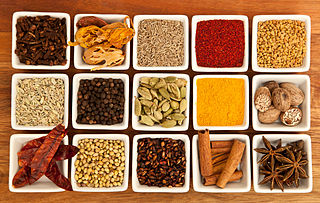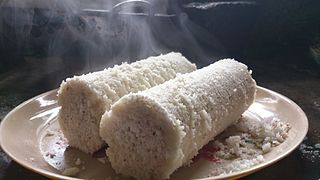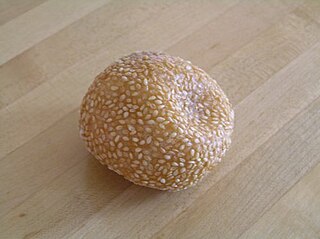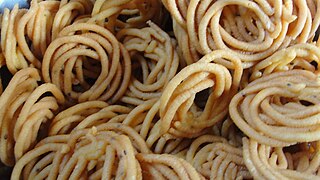
Glutinous rice is a type of rice grown mainly in Southeast and East Asia and the eastern parts of South Asia, which has opaque grains, very low amylose content, and is especially sticky when cooked. It is widely consumed across Asia.
Sri Lankan cuisine has been shaped by many historical, cultural and other factors. Contact with foreign traders who brought new food items, cultural influences from neighbouring countries as well as the local traditions of the country's ethnic groups among other things have all helped shape Sri Lankan cuisine. Influences from Indian, Indonesian and Dutch cuisines are most evident with Sri Lankan cuisine sharing close ties to other neighbouring South and Southeast Asian cuisines. Today, some of the staples of Sri Lankan cuisine are rice, coconut and spices. The latter are used due to the country's history as a spice producer and trading post over several centuries.

A Papadum is a thin, crisp, disc-shaped food from the Indian subcontinent, typically based on a seasoned dough usually made from peeled black gram flour, either fried or cooked with dry heat. Flours made from other sources such as lentils, chickpeas, rice, tapioca, certain millets or potato can be used.

Puran poli is an Indian sweet flatbread.

Idiyappam is a rice noodle dish originating from the Indian subcontinent. It consists of rice flour pressed into noodle form and then steamed. The food, popular in Sri Lankan cuisine and Indian cuisine, also spread to Southeast Asia, where it is called putu mayam in Malaysian and putu mayang in Indonesian. Sometimes, it is called string hoppers in English.

The cuisine of Karnataka includes many vegetarian and non-vegetarian cuisines. It is one of the oldest surviving cuisines and traces its origin to the Iron Age. Ragi is mentioned in the historical works of the great poet Adikavi Pampa and in the ancient Sanskrit medical text Sushruta Samhita. The varieties of the Karnataka cuisine have drawn influence from and influenced the cuisines of neighbouring states like Tamil Nadu, Andhra Pradesh and Kerala. Although the ingredients differ from one region to another, a typical Kannadiga Oota includes the following dishes in the order specified and is served on a banana leaf: Uppu (salt), Kosambari, Pickle, Palya, Gojju, Raita, Payasa (Kheer), Thovve, Chitranna, Anna (rice), and Tuppa (ghee).

Puttu, or pittu, is a breakfast dish originating from the Indian state of Kerala, eaten in Kerala, Tamil Nadu, parts of Karnataka, and Sri Lanka. Puttu means "portioned" in Malayalam. It is made of steamed cylinders of ground rice layered with coconut. It is highly popular in the Indian state of Kerala as well as in many areas of Sri Lanka, where it is also known as pittu. Puttu is served with side dishes such as palm sugar or chickpea curry or banana. In Bhatkal Puttu is served with side dishes such as ghee and sugar or Paya.

Appam is a type of pancake, originating from the Indian subcontinent, made with fermented rice batter and coconut milk. The origin of Appam is disputed and potential sources of origin might be Sri Lanka or the southern tip of India. It is a common food in Sri Lanka, Tamil Nadu and Kerala where it is eaten most frequently for breakfast or dinner.

Kue is an Indonesian bite-sized snack or dessert food. Kue is a fairly broad term in Indonesian to describe a wide variety of snacks; cakes, cookies, fritters, pies, scones, and patisserie. Kue are made from a variety of ingredients in various forms, some are steamed, fried or baked. Kue are popular snacks in Indonesia, which has the largest variety of kue. Because of the countries' historical colonial ties, Koeé (kue) is also popular in the Netherlands.

Jian dui is a type of fried Chinese pastry made from glutinous rice flour. The pastry is coated with sesame seeds on the outside and is crisp and chewy. Inside the pastry is a large hollow, caused by the expansion of the dough. The hollow of the pastry is filled with a filling usually consisting of lotus paste, or alternatively sweet black bean paste, or less commonly red bean paste. They are also sometimes referred to as sesame balls.

Kuswar is a term often used to mention a set of unique Christmas goodies which are part of the cuisine of the Goan Catholic community of Goa and the Mangalorean Catholic community of Karnataka, India. There are as many as 22 different traditional recipes that form this distinct flavour of Christmas celebration in Goa and Mangalore. Kuswar originally hails from Goa, India.
Palathalikalu is an Indian sweet dish made during Sankranthi in the Delta region of Andhra Pradesh, India.

Kiribath is a traditional Sri Lankan dish made from rice. It is prepared by cooking rice with coconut milk, hence this name, and can be considered a form of rice cake or rice pudding. Kiribath is an essential dish in Sri Lankan cuisine. It is very commonly served for breakfast on the first day of each month and also has added significance of being eaten for any auspicious moment throughout one's lifetime which are marking times of transition. It is one of the more renowned traditional dishes in Sri Lanka.

Kokis is a deep-fried, crispy Sri Lankan food made from rice flour and coconut milk. Although considered as a traditional Sri Lankan dish, it is believed to have come from the Dutch. This is an important dish when celebrating Sinhala and Tamil New Year and plays a major role in the festivities.
Athirasa or Athiraha is a sweet in Sri Lankan cuisine. It is a sweet-cake of jaggery and rice flour made into a paste flattened into circles and fried. Athirasa is also famous in India for Diwali. Athirasa is served on festive occasions along with other sweets such as Kavum, Kokis, and Aluwa.

Murukku is a savoury, crunchy snack originating from the Indian subcontinent, popular in southern India, and Sri Lanka. The snack's name derives from the Tamil word for "twisted", which refers to its shape. In India, Murukku is especially popular in the states of Tamil Nadu, Kerala, and Andhra Pradesh. It is also popular in countries with substantial presence of Indian and Sri Lankan diaspora, including Singapore, Fiji, and Malaysia.

Kalu dodol is a sweet dish, a type of dodol that is popular in Sri Lanka. The dark and sticky dish consists mainly of kithul jaggery, rice flour and coconut milk. Kalu dodol is a very difficult and time-consuming dish to prepare. The Hambanthota area is famous for the production of this dish.
Aggala are a traditional Sri Lankan sweet. They are essentially sweet roasted rice balls, made from rice, coconut, jaggery or treacle and pepper.



















